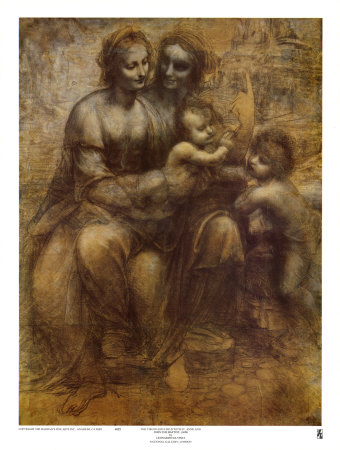Three near-invisible drawings discovered on back of Da Vinci masterpiece
 | The mystery is set in the Louvre and the clues are hidden behind a 16th-century masterpiece by Leonardo da Vinci. Remind you of anything?
Lovers of Dan Brown novels will be salivating at the discovery of three previously unknown drawings on the back of one of Leonardo’s major works. A curator spotted the sketches on the back of The Virgin and Child with Saint Anne when it was taken down in September for restoration.
Sylvain Laveissière pointed out some grey marks that had previously been dismissed as stains. To him they resembled a horse’s head and a human skull.
When the painting was photographed with an infra-red camera at the Centre for Research and Restoration of the Museums of France, he was proved right. On the wood on which the work was mounted was an 18cm by 10cm (7in by 4in) equine head and a 16.5cm by 10cm skull, complete with orbital and nasal cavities, jaw and teeth. The camera detected a third drawing, a 15cm-high infant Jesus with a lamb, which was invisible to the naked eye.
|
A spokeswoman for the Louvre said that the discovery was “amusing and moving”. It is also mysterious, since the drawings appear to have gone unnoticed for 500 years.
“They were not meant to be kept,” said Bruno Mottin, of the Louvre’s art laboratory. “They had been largely wiped out, which explains why no one had spotted them until now.”
The Louvre said there that was evidence to suggest that the sketches — in black stone or charcoal — were indeed by the great man. “We’re being very careful,” said Vincent Pomarède, head of paintings at the Louvre, “but what is troubling is the similarity with drawings that are already known.”
The skull resembles those in Leonardo’s other sketches, and the horse’s head is reminiscent of those in The Battle of Anghiari — a lost masterpiece known only because it was copied. The baby Jesus appears to be a draft for the figure in The Virgin and Child with Saint Anne.
Mr Pomarède said that Leonardo may have used the back of the painting to practise on.
Jill Burke, an Italian Renaissance specialist at Edinburgh University, said: “It would be quite typical of his working style for him quickly to sketch out ideas that came into his head on whatever paper — or, in this case, panel — was to hand.”
The Louvre said that it would carry out tests to try to confirm the identity of the author.
Although other art experts have suggested that one of Leonardo’s many followers may have been responsible for the sketches, all agree that there is no material here for a Dan Brown sequel. Francis Ames-Lewis, an art historian and vice-president of the Leonardo da Vinci Society, said it was a myth that the artist included coded messages in his works.
The Virgin and Child with Saint Anne has been accompanied by mystery before, however. Leonardo brought it to France with the Mona Lisa, when he joined the court of Francis I in about 1516.
Mr Franck said: “We don’t look at the backs of paintings enough.”
Codes and conspiracies
— The discovery of sketches behind The Virgin and Child with Saint Anne, right, may give ammunition to those who believe that Leonardo da Vinci planted codes and religious symbols in many of his paintings
— The Da Vinci Code is based on a theory that the figure on Christ’s right in The Last Supper is not the Apostle John but Mary Magdalene. It claims that Jesus and Mary married and have descendants alive today
— According to the theory the Holy Grail is not an object, but Mary, the “sacred feminine” and carrier of the bloodline of Christ. The location of the grail is her resting place
— In 2007 Slavisa Pesci, an amateur scholar, said that by superimposing The Last Supper with its mirror image one could create another picture containing a figure who looks like a Templar knight
— A computer technician claimed to have found musical notes encoded in The Last Supper. Each loaf of bread was said to represent a note, creating a 40-second “requiem-like” composition
Watch the Video
Liked it ? Want to share it ? Social Bookmarking
Discuss and comment on article |
Article Link
|
More ghost stories on Unexplained Mysteries
|






